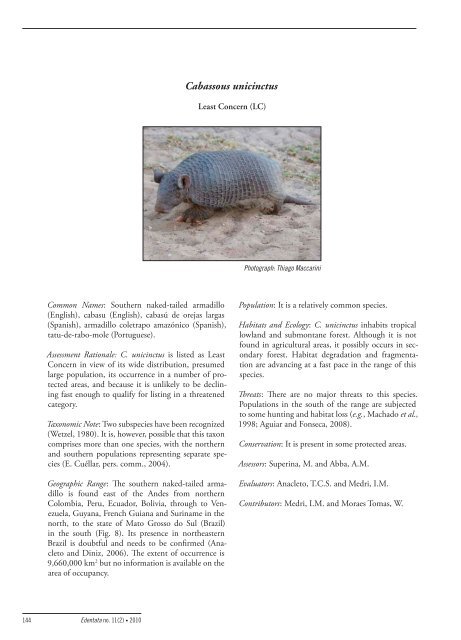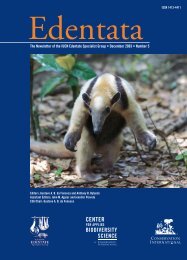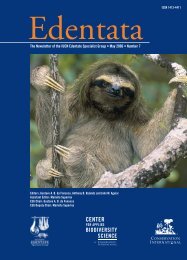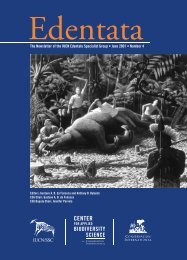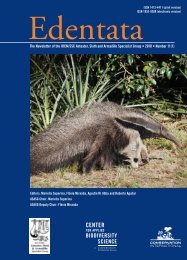Edentata 11(2), 2010 - Anteater, Sloth & Armadillo Specialist Group
Edentata 11(2), 2010 - Anteater, Sloth & Armadillo Specialist Group
Edentata 11(2), 2010 - Anteater, Sloth & Armadillo Specialist Group
- No tags were found...
Create successful ePaper yourself
Turn your PDF publications into a flip-book with our unique Google optimized e-Paper software.
Cabassous unicinctusLeast Concern (LC)Photograph: Thiago MaccariniCommon Names: Southern naked-tailed armadillo(English), cabasu (English), cabasú de orejas largas(Spanish), armadillo coletrapo amazónico (Spanish),tatu-de-rabo-mole (Portuguese).Assessment Rationale: C. unicinctus is listed as LeastConcern in view of its wide distribution, presumedlarge population, its occurrence in a number of protectedareas, and because it is unlikely to be decliningfast enough to qualify for listing in a threatenedcategory.Taxonomic Note: Two subspecies have been recognized(Wetzel, 1980). It is, however, possible that this taxoncomprises more than one species, with the northernand southern populations representing separate species(E. Cuéllar, pers. comm., 2004).Geographic Range: The southern naked-tailed armadillois found east of the Andes from northernColombia, Peru, Ecuador, Bolivia, through to Venezuela,Guyana, French Guiana and Suriname in thenorth, to the state of Mato Grosso do Sul (Brazil)in the south (Fig. 8). Its presence in northeasternBrazil is doubtful and needs to be confirmed (Anacletoand Diniz, 2006). The extent of occurrence is9,660,000 km 2 but no information is available on thearea of occupancy.Population: It is a relatively common species.Habitats and Ecology: C. unicinctus inhabits tropicallowland and submontane forest. Although it is notfound in agricultural areas, it possibly occurs in secondaryforest. Habitat degradation and fragmentationare advancing at a fast pace in the range of thisspecies.Threats: There are no major threats to this species.Populations in the south of the range are subjectedto some hunting and habitat loss (e.g., Machado et al.,1998; Aguiar and Fonseca, 2008).Conservation: It is present in some protected areas.Assessors: Superina, M. and Abba, A.M.Evaluators: Anacleto, T.C.S. and Medri, I.M.Contributors: Medri, I.M. and Moraes Tomas, W.144<strong>Edentata</strong> no. <strong>11</strong>(2) • <strong>2010</strong>


